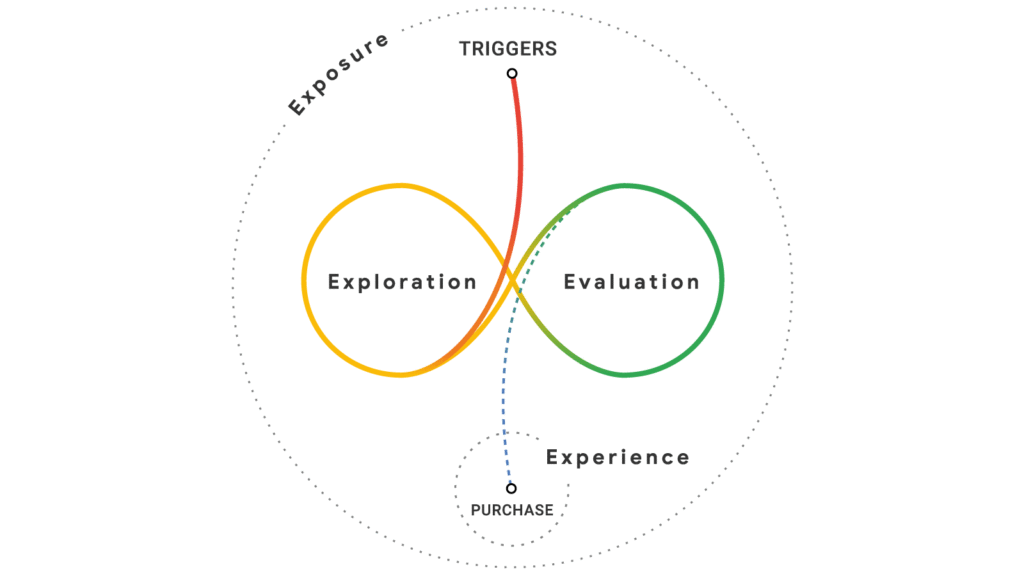June 2, 2021
Takeaways From the Google Marketing Livestream 2021
Last week, the PHOS team attended the Google Marketing Livestream 2021. Described as a virtual keynote, Google put together presentations from their staff, industry experts, and successful partners to announce their new products and plans for the future of marketing within Google.
If you weren’t aware, Google accounts for over 90% of worldwide searches, and Google Ads revenue amounted to 146.92 billion US dollars in 2020. Therefore, as the expert marketers we are…when Google talks, we listen.
Read on to see some of our biggest takeaways from #GML2021!
The “New” Customer Journey
Throughout multiple keynotes, Google team members referred to their idea of the “New Customer Journey” (as seen below). Essentially, they say that once a customer starts looking at a product or service, they can cycle endlessly from exploration to evaluation for any amount of time before making a purchase decision — if ever. Customers are doing incredible amounts of research prior to a decision, and they need the best resources possible to assist in their search. If this sounds familiar, it’s because it’s very similar to inbound marketing. The theory behind inbound is that by providing your customers with value prior to their decision, they will want to go with whoever educated and assisted them the best. Ideally, that’s you.

All this considered, Google is making many of its choices from a marketer’s point of view. They’ve spent hundreds of thousands of hours honing their abilities to predict user experience and behavior, and now they’re giving those abilities to advertisers.
Automations, Roll Out
With smart bidding, broad match keywords, and responsive ads, Google has created a formula that has led to a 20% increase in conversions for some advertisers. That is to say, Google knows what performs best, and they want advertisers to trust that. Instead of experimenting with dozens of combinations or headlines and descriptions, Google is able to streamline the process and do it automatically. Broad match keywords themselves are nothing new, but the automation behind how they can identify what someone is looking for with a search query gets better results every second.
The investment behind automations isn’t stopping, and Google announced that it will be researching ways to streamline the process, so there’s no ramp-up to responsive ads yielding results. They also brought up that they are continuing to release more information behind their automated process so advertisers can obtain clear points of evidence that demonstrate the value of their automated campaigns.
Privacy as a Priority
The topic on everyone’s minds these days is privacy: do we have control over our own data? In the wake of that discussion, Google announced its intentions last year to phase out the use of third-party cookies by 2022. With Apple implementing its iOS14 update in recent months, Google needed to come through with a way for advertisers to retarget their customers. GLM2021 talked about building a “privacy-safe, ad-funded internet, together,” but what does that really mean for ads?
Cookies Are Getting Stale
Speaking of Apple, their new opt-in approach to third-party data tracking has started the countdown for cookies, and Google is ready. GLM announced that Google will instead be creating ways for advertisers to utilize their own consented, first-party data. This means that any information collected directly from your audience (think website forms, app accounts, in-store feedback forms) can be input into the new Customer Match tool to retarget those customers across all of Google’s platforms. Advertising tools will then rely on modeled data to fill in any gaps left by third-party data. Google’s headed to the future, and where we’re going, we might not need cookies.
Google Tag Manager
Conversion attribution has long been the white whale of marketing. With hundreds of potential touchpoints, it can be near-impossible to fully understand a customer’s purchase decision. With the addition of Consent Mode, advertisers can connect their website’s cookie consent banner with Google Tag Manager. This allows Google to still track your ad conversions through cookies just like they always have, so long as the user opts-in to the storage of ad cookies. If the user doesn’t accept cookies, then Google Tag Manager won’t track their actions and will instead use aggregate data to infer what happened leading up to a purchase decision.
Google Analytics
Consent Mode will also work hand-in-hand with Analytics. Just like the ad-specific cookies, users will need to opt-in to your website’s analytics cookies from your consent banner. This optional tracking is completely based on the user’s choices. For example, if a user opts-in for ad cookies but denies analytics, then Google can attribute a conversion to a specific ad but won’t record their website behavior. Keep in mind that Google announced its default will be Google Analytics 4, so all of these changes are going to exist there.
Behavioral Reporting in Analytics will also benefit from Google’s modeling data. The addition of Google’s data promises to deliver insights into the complete customer journey even when cookies aren’t available. Only time will tell how useful their modeling data can be.
Final Thoughts
It’s never been a more exciting time to be a marketer. But that also comes with the weight of learning how to leverage all of these new tools to the benefit of your business. Google has put a lot of thought and effort into creating a comprehensive experience that benefits those who utilize the entire Google network.
When it comes time to make decisions about how to market your digital storefront, make sure you have a team of experts who are committed to staying one step ahead of the competition. At PHOS, we are passionate about creating campaigns that differentiate you from the digital masses.







